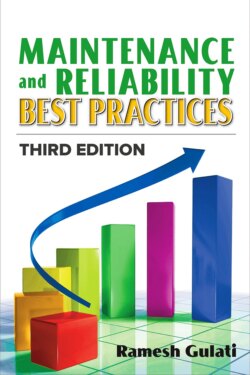Читать книгу Maintenance and Reliability Best Practices - Ramesh Gulati - Страница 8
На сайте Литреса книга снята с продажи.
ОглавлениеForeword to the Third Edition
The Mars rovers Spirit and Opportunity were launched individually in the summer of 2003 and touched down in January of 2004 in different regions of the planet. Each was equipped with a panoramic camera, a macro camera, spectrometers for identifying rocks and minerals, and a little drill for taking samples. The goal was to operate for 90 days, traveling about 40 meters each day and ultimately covering about a kilometer. Both exceeded those goals by incredible amounts. Spirit ended up traveling about 7.7 kilometers and lasting about 7 years.
Opportunity outshone its twin, going some 45 kilometers over 14 years.
No maintenance! High reliability.
The best practice for maintenance is zero. A maintenance-free asset is a dream come true for asset owners. As Ramesh Gulati has taught us for years, the time to influence such an outcome is in early asset life cycles such as specification, design, creation/build and commissioning. The required maintenance is locked in place once the asset begins its operating life. One’s influence on reliability, sustainability, safety, and total cost of ownership are limited after commissioning.
Yet, most assets are not maintenance-free. You will have to read 10 Rights of Asset Management (ISBN 978-1-941872-83-3) to learn more about the benefits of Reliability-Centered Design (RCD) as we refer to it in Uptime Elements Reliability Framework and Asset Management System or Design for Reliability (DFR) as Ramesh and his colleagues refer to it.
The issues around determining maintenance requirements for an asset were settled over 40 years ago with Nolan and Heaps seminal work “Reliability–Centered Maintenance” or RCM, commissioned by the Department of Defense in collaboration with United Airlines. The result of a thorough RCM analysis is a “technically valid” and “economically feasible” preventive maintenance strategy that is aimed at safely ensuring that the asset or system will deliver its function at the lowest possible cost.
Easy to say, much more challenging to do. Reliabilityweb research indicates that over 70% of maintenance improvement initiatives fail to generate sustainable business success, meaning, it never shows up on the financial statement.
In this book, Ramesh Gulati takes us on a 360-degree journey that includes technical approaches, effective processes, and, most importantly, people in order to reverse the trend of failed improvement efforts with proven strategies and tactics.
Unlike many authors, Ramesh is both a subject matter expert and an experienced master practitioner with a 40+ year record of highperformance reliability results. He has added so much value in various maintenance and reliability communities by sharing his own knowledge and through encouraging others to share their knowledge. He not only adds insight, but he also changed our perspective by working in “system” thinking, whole life asset management, and ethical humanity.
Ramesh has always been a “Reliability Sherpa” or guide for the rest of us. He knows it is you who must do the hard work of climbing the maintenance mountain, but he stands with you to let you know about challenges that are just around the corner, and he asks thoughtprovoking questions that allow us to discover for ourselves powerful insights that advance our thinking and our practices.
This book is also often referenced as one of the best resources for preparing for Professional Certification exams, and I endorse that use highly.
I suspect that maintainers will use this book 50 years from now to ensure that the infrastructure for our interplanetary settlements and that our speed-of-light flying cars are reliable.
In the meantime, don’t just use this book as a study guide; use it as your own personal Reliability Sherpa. The lessons it teaches advance as you do, so a one-time read is not enough. This is your go-to reference as you work to achieve reliability and advance asset management.
Use it well.
I am grateful for this opportunity.
Terrence O’Hanlon
Reliability Leader
Coauthor, 10 Rights of Asset Management
